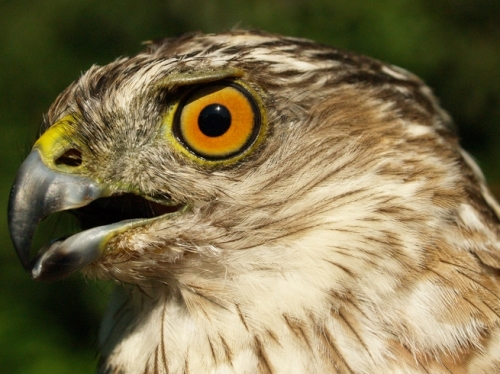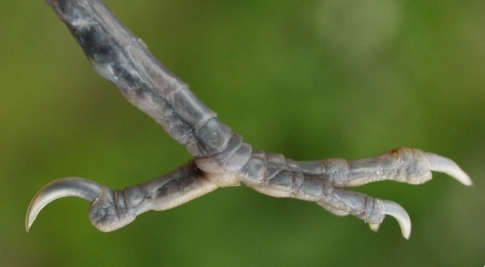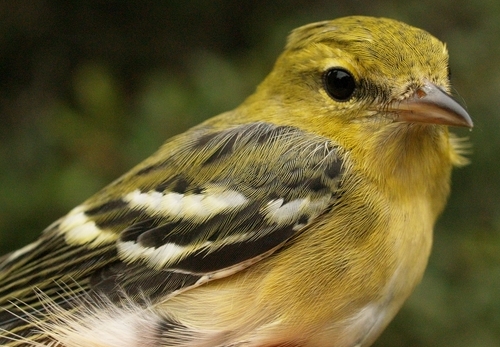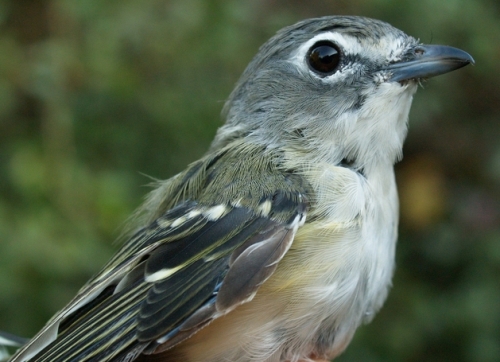|
McGILL BIRD OBSERVATORY |
||||||||||||||||||||||||||||||||||||||||||||||||||||||||||||||||||||||||
Welcome
to the McGill Bird Observatory weekly report.
Click here for a complete listing of our archives.
Bander-in-charge: Simon Duval Notes: In terms of the number of birds banded, this was the slowest week so far this fall. However, the 177 birds banded match the average for this week over the past five years, and the cumulative total of 868 over the first four weeks of fall is still over 100 more than we have ever had at this point of the season. As noted last week though, we are still at a record number of net hours for the season, after another week in which very little rain or wind interfered with operations. Also consistent with previous weeks this fall, our count of species observed was well below average, and this marks the first time that we haven't cracked a cumulative total of 100 for the fall by the end of week four. This week our list of species observed for the first time this fall is a short one of just three birds: Bay-breasted Warbler, Lincoln's Sparrow, and Purple FInch. The first two from that list were also among species banded for the first time this fall, in addition to Blue Jay, Blue-headed Vireo, and Scarlet Tanager. Except for the vireo and sparrow, those were actually new records for the entire year.
As noted in the caption above, we have already banded a record number of Canada Warblers this fall, even though we haven't reached the end of our first month of migration (though admittedly, Canada Warblers are very early migrants, and our total isn't likely to grow much further). It is also turning into a good season for Chestnut-sided Warblers, with 22 banded so far (average fall total 18; record high 29) and American Redstarts, at 99 and counting (average fall total 79; record high 104). Outside of the warblers, another species potentially on pace for a record-setting season is Indigo Bunting. We have banded 32 over the first four weeks, a period during which our five-year average is only 10. However, over the remainder of the season, our average has been 21 - even if we only match that number, the season total will exceed the record high of 51 established just last year. It will be interesting to see whether the buntings were simply migrating earlier this fall, or the count will remain above average throughout the season. It is worth noting, especially with respect to the high warbler numbers, that the abundance of mosquitoes (and probably also some other less aggravating insects) at MBO this August has been unprecedented. To some extent, this may be correlated to the continuing above-average heat and humidity. As much as all the warblers have been welcome, the field crew wouldn't mind a bit of cooler air to keep the insects under control. Bug nets have been essential on many days, and the reduced visibility they cause may also be a factor in observations being down a bit so far this fall. If in fact the above average warbler numbers can be connected to the abundance of insects (both at MBO and in the boreal forest), it's surprising that for the most part our flycatcher numbers have been low this fall. Most species are early migrants, peaking in August, and numbers banded so far this season are low almost across the group. Traill's Flycatcher (mostly Alder, some Willow) is usually our most abundant flycatcher, and is again this year, but with only 10 individuals banded to date, compared to a previous average of 18 by this point in the season. Except for Least Flycatcher (9 banded this year vs. the five-year average of 7) and Yellow-bellied Flycatcher (6 vs. 5), the pattern holds for all the other flycatchers: Eastern Kingbird (0 vs. 1), Great Crested Flycatcher (1 vs. 2), Eastern Phoebe (2 vs. 3), and Eastern Wood-Pewee (0 vs. 1). Admittedly, most of these species we band in such small numbers that the differences noted aren't meaningful, but it is interesting that none of them are substantially more numerous this year than usual, as is the case with several of the warblers.
Magnolia Warbler took a wide lead over other species on this week's list of most frequently banded birds, which was no surprise given that they have held top position in week 4 every previous fall except 2009. Meanwhile, this marks the fourth consecutive year that American Redstart has ranked second during this week. We banded a similar number of Red-eyed Vireos in week 4 both in 2007 and 2009, but in other years they didn't even crack the top ten at this time of year. Thanks to the five-way tie for tenth place, we ended up with nine warbler species on the list this week, only two of which (Wilson's Warbler and Northern Waterthrush) were not also on last week's list. Among species observed, the top four are the same as last week, except for Black-capped Chickadee and Common Grackle swapping places. American Crow was the most abundant species for a third straight week, similar to the pattern we observed at this time of year in 2007. Magnolia Warbler jumped up to fifth place this week, matching the highest rank we've seen for this species, though the other two times it occurred later in the season (a mean daily count of 13 in week 5 of 2008, and an impressive 23 in week 6 of the same year). Canada Goose and Gray Catbird were the lone additions to the list this week; whereas catbird numbers are likely to start declining soon, goose flocks are expected to build throughout the fall, and it would not be surprising to see them remain on this list for the rest of the season.
|






